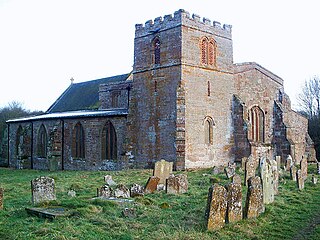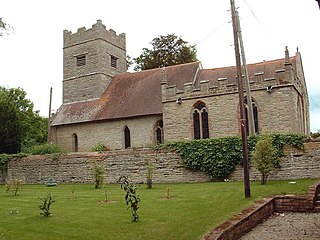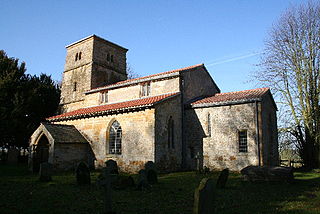
St Peter's Church is in the small hamlet of Aston-by-Sutton, Cheshire near to the town of Runcorn. The church is recorded in the National Heritage List for England as a designated Grade I listed building. It is an active Anglican parish church in the diocese of Chester, the archdeaconry of Chester and the deanery of Great Budworth. It is one of three parish churches in the parish of Aston-by-Sutton, Little Leigh and Lower Whitley. The other two being St Michael and All Angels, Little Leigh and St Luke, Lower Whitley. The three were previously individual parishes united in a benefice along with St Mark, Antrobus. The listing describes it as "a most pleasing late 17th to early 18th-century church, inside and out". The church stands in a relatively isolated position in the south side of Aston Lane in the hamlet.

St Mary's Church is an Anglican parish church in the village of Newbold Astbury, Cheshire, England. It is recorded in the National Heritage List for England as a designated Grade I listed building, and its architecture has been praised by a number of writers.

St Nicolas Church is an Anglican church in the Portslade area of the English city of Brighton and Hove. It has 12th-century origins, and serves the old village of Portslade, inland from the mostly 19th-century Portslade-by-Sea area.

All Saints' Church, Kedleston, is a redundant Anglican Church located 4 miles north-west of Derby in Derbyshire, England. It is all that remains of the medieval village of Kedleston, which was demolished in 1759 by Nathaniel Curzon to make way for the adjacent Kedleston Hall, a country house in Derbyshire, England. It is recorded in the National Heritage List for England as a designated Grade I listed building. Kedleston Hall is owned by the National Trust, and the church is under the care of the Churches Conservation Trust. Kedleston Hall has been occupied by the Curzon family for over 700 years.

St Bartholomew's Church is a redundant Anglican church in the village of Richard's Castle, Herefordshire, England. It is recorded in the National Heritage List for England as a designated Grade I listed building, and is under the care of the Churches Conservation Trust. It stands close to the castle of the same name as the village, which was built to command this part of the Welsh Marches. The village is partly in Shropshire and the county boundary is not far from the church.

St Cuthbert's Church is a redundant Anglican church about 1 mile (1.6 km) to the southeast of the village of Holme Lacy, Herefordshire, England. It stands in an isolated position at the end of a lane in a bend of the River Wye. It is designated in the National Heritage List for England as a Grade I listed building, and is under the care of the Churches Conservation Trust.

St Peter's Church is a redundant Anglican church standing in an isolated position in the civil parish of Wolfhampcote, Warwickshire, England. Since 1960 the church and its attached mausoleum have been recorded in the National Heritage List for England as a designated Grade II* listed building, and are now under the care of the Churches Conservation Trust. The church stands in a field which contains a number of mounds. These are partly the remains of the medieval village initially served by the church, which has been deserted village for centuries, partly from disused canal workings, and partly from the remains of a redundant railway line.

All Saints' Church, Spetchley, is a redundant Anglican church adjacent to Spetchley Park, Worcestershire, England. It is recorded in the National Heritage List for England as a designated Grade II* listed building, and is under the care of the Churches Conservation Trust.

St Peter's Church is a redundant Anglican church in Kingerby, Lincolnshire, England. It is recorded in the National Heritage List for England as a designated Grade I listed building, and is under the care of the Churches Conservation Trust. The church stands in an isolated position opposite the grounds of Kingerby Hall.

All Saints Church is a redundant Anglican church in the village of Little Wenham, Suffolk, England. It is recorded in the National Heritage List for England as a designated Grade I listed building, and is under the care of the Churches Conservation Trust. It stands in an isolated position close to Little Wenham Hall, about 0.6 miles (1 km) to the northwest of Capel St. Mary.

Old St Peter and St Paul's Church is a former Anglican church near the village of Albury, Surrey, England in the care of The Churches Conservation Trust. It is recorded in the National Heritage List for England as a designated Grade I listed building. The church stands in Albury Park, to the northwest of Albury Hall, and between the villages of Albury and Shere.

St Nicholas's is a parish church in Otham, Kent begun in the 12th century with additions in the next two centuries. It is a Grade I listed building.

St Nicholas is a Church of England parish church in Leeds, Kent first built in the 11th century with additions in the next five centuries. It is a Grade I listed building.

St Mary's is a parish church in Lenham, Kent, England, begun in the 12th century with additions in the next three centuries. It is a Grade I listed building.

St John the Baptist's Church is a parish church in Marley Road, Harrietsham, Kent dedicated to John the Baptist. It was begun in the late 11th century or in the 12th century and works continued to the 15th century. The church is a Grade I listed building.

All Saints' Church is a 13th-century pilgrims' Grade I listed church in Boughton Aluph near Ashford, Kent. It is part of the Church of England.

St Cuthbert's Church is located near the village of Edenhall, Cumbria, England. It is an active Anglican parish church in the deanery of Penrith, the archdeaconry of Carlisle, and the diocese of Carlisle. Its benefice has been united with those of seven local parishes to form the Cross Fell Group of churches. The church is recorded in the National Heritage List for England as a designated Grade I listed building. It stands to the southeast of the village, and is surrounded by parkland.

St Peter's and St Paul's Church is a parish church in Yalding, Kent, dedicated to saints Peter and Paul. It was begun in the 13th century and is a Grade I listed building.

St Eata's Church is in the village of Atcham, Shropshire, England. It is an active Anglican parish church in the deanery of Shrewsbury, the archdeaconry of Salop, and the diocese of Lichfield. Its benefice is united with that of St Giles-with-Sutton, Shrewsbury. The church is recorded in the National Heritage List for England as a designated Grade I listed building. Its dedication to Eata of Hexham is unique.

St Nicholas' Church is a Grade I listed parish church in the village of Berden, Essex, England.






















